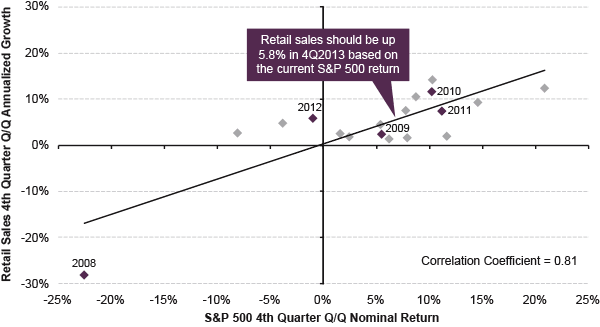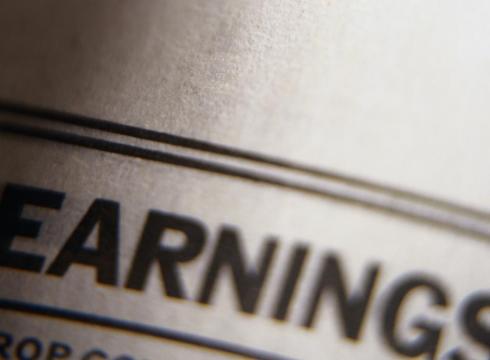November 26 2013
As this bull market climbs its “wall of worry,” we can see its underlying strength. Valuation concerns and the risk of a major correction appear overblown, as we should see a continued rebound in economic fundamentals over the coming months.
by Scott Minerd, Global CIO, Guggenheim Partners LLC
Approaching December, it is worth taking a closer look at recent U.S. stock market performance for a clearer indication of where we might be headed. There has been much talk lately of 2013’s year-long equity rally, but taking a more granular view yields a more nuanced version of events. The U.S. stock market enjoyed gains during the first four months of 2013, but then, in the midst of the “rally,” between the highs of May and the lows of October, stocks posted a 1 percent loss and heightened volatility.
While that decline was by no means severe, markets don’t necessarily have to sell off to consolidate, they can just move sideways. So while some investors are still waiting for a correction, we have already seen at least one consolidation come and go. From the bottom in October up until today, the S&P 500 has rallied more than 9 percent. Now, after the magnificent gains starting in October and with the most recent retail sales data beating expectations, we head into the crucial holiday season with a lot of momentum.
As the old Wall Street adage goes, all bull markets climb a “wall of worry.” The current one appears to be no exception. The pattern of the stock market this year suggests that the current rally has a great deal of strength behind it. Concerns over valuations and the risk of a major correction appear overblown. Abundant liquidity and seasonal factors are now buoying the market, and as the effect of October’s U.S. government shutdown is flushed from the system, we should see a continued rebound in economic fundamentals in the coming months.
Chart of the Week
Equity Market Performance and U.S. Holiday Sales Outlook
Rising equity prices boost household net worth and translate into consumption via the so-called wealth effect. This relationship is particularly meaningful for the U.S. economy during the final quarter of the year. Historically, growth in fourth quarter retail sales, the holiday shopping season, has been closely related with equity performance during the same period. The expectation of higher U.S. equity prices due to abundant liquidity and low interest rates will likely support this year’s holiday sales.
S&P 500 4TH QUARTER RETURNS VS. RETAIL SALES 4TH QUARTER GROWTH

Source: Bloomberg, Guggenheim Investments. Data as of 11/25/2013.
Economic Data Releases
U.S. Pending Home Sales Lower, While Prices and Permits Rise
- Pending home sales fell unexpectedly in October, decreasing 0.6%, the fifth straight monthly decrease.
- Building permits rose strongly in October, up 6.2% to an annual pace of 1.03 million, following September’s gain of 974,000. October saw the most permits issued since June 2008.
- The S&P/Case-Shiller 20-City Home Price Index accelerated to 13.3% growth from a year ago, the fastest since February 2006.
- The FHFA house price index rose 0.3% in September, the lowest monthly growth in one year.
- The Conference Board’s Consumer Confidence Index unexpectedly fell in November, dropping two points to 70.4.
- Initial jobless claims fell for a sixth straight week to 323,000 for the week ended November 16th.
- Job openings increased to 3.91 million in September, from 3.84 million last month, a 1.8% increase and slightly more-than-expected.
- The Philadelphia Fed Business Outlook Survey decreased to 6.5 in November, a six-month low.
- The Richmond Fed manufacturing index rose to 13 in November from 1 in October.
- The Producer Price Index fell 0.2% in October, and the year-over-year reading remained at 0.3%.
Euro Zone Confidence Falls, Services Expansion Slows
- Euro zone consumer confidence decreased for the first time in over a year in November, falling to -15.4.
- The euro zone manufacturing PMI met expectations in November, ticking up 0.2 to a reading of 51.5, a two-and-a-half year high. The services PMI, however, fell unexpectedly to 50.9.
- The manufacturing PMI in Germany rose to 52.5 in November, the highest since June 2011.
- Germany’s IFO business climate index rose to the highest level since April 2012, beating expectations.
- France’s manufacturing PMI unexpectedly dropped to 47.8 in November, the lowest since May. The services PMI decreased below 50.
- Italian consumer confidence rebounded in November to 98.3, the second best reading this year.
- China’s HSBC flash manufacturing PMI was under expectations in November at 50.4, falling from 50.9 in October.
Copyright © Guggenheim Partners LLC













